German Rural Police Officer's Service Tunic
CATEGORY: Version
SKU: 52.GOR.02.01.01.02.003.000
Estimated market value:
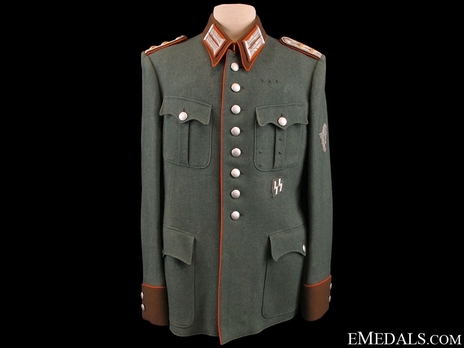
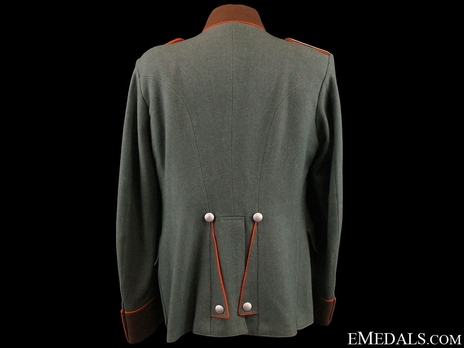
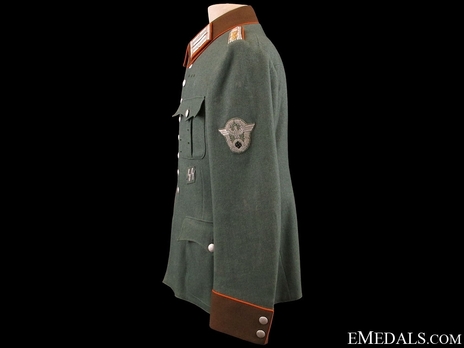
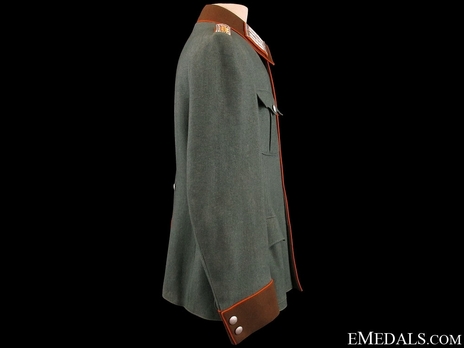
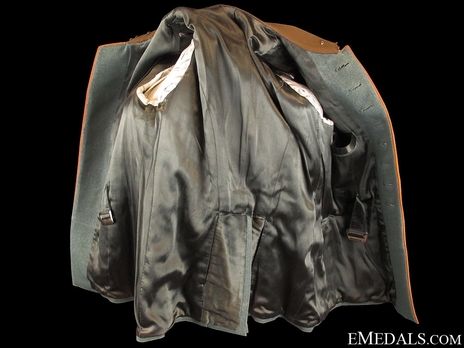
Estimated market value:
This tunic is fabricated from green wool and is trimmed with chocolate brown wool on the collar and the simulated French cuffs, with orange piping. It is adorned with silver/aluminum bullion wire shoulder boards, each with two gilt pips attached, trimmed in chocolate brown piping with orange wool bases, held in place by silver gilt pebbled buttons. The collar tabs are in silver bullion wire with orange wool bases. There is a dual hook and eye closure on the collar, ensuring a snug fit at the neckline. The underside of the collar has three clips: one on either side and one at the back, for placement of a protective paper collar. The upper left sleeve has a hand-embroidered, wreathed police eagle insignia badge in bright silver/aluminum wire and bullion threads with a black embroidered swastika on a cut-out, all on a green wool base, the base slightly lighter than the colour of the uniform. The front has four pockets, one on each breast which are pleated and one at the waist on both sides, which are covered by scalloped button down flaps, each with reinforced button holes, with silver gilt pebbled buttons underneath on the pockets. The left breast has three horizontal thread loops above the left breast pocket and two pairs of vertical loops on the pocket itself, for the wearing of a ribbon bar and two awards, respectively. The lower left breast has a hand embroidered SS runes in bright silver/aluminum wire threads on a green wool base. The front is completed by a vertical row of eight silver pebbled buttons on the right side, facing an equal number of reinforced button holes on the left, trimmed in orange piping on both open sides of the tunic. The rear of the tunic has a single vented tail skirt, with elongated straps on either side of the opening, again trimmed in orange piping with two silver buttons each. The cuffs each have two silver pebbled buttons attached. The inside is lined in a forest green rayon, with one large pocket on the breast and one slot below for a sword or bayonet at the waist, both on the left side. There is a belt sewn in place at the waist on both sides, with polished, magnetic hardware, the right side buckle with a clip and the left side buckle with the receiving slot, allowing for a snug fit at the waistline. The sleeves are lined in white cotton with vertical stripes. The runes are still quite clean and bright and the base is neatly hand stitched to the tunic. All the buttons appear to have their original stitching. The tunic has no visible size or manufacturer's markings and measures 460 mm across the shoulders and 710 mm in length overall. There is evidence of moth invasion in scattered places on the left sleeve and above the left breast pocket. It displays a nice texture in the wool, quality workmanship, beautiful, intact stitching, very clean, in extremely fine condition.
During the Third Reich, an effort was made to unite all of Germany’s disparate provincial police forces and agencies into a single cohesive national unit. To attain this goal, Reichsführer-SS Heinrich Himmler was named Chief of the German Police in the Ministry of the Interior in June 1936. That same month, Himmler implemented new standardized uniforms, headgear, and insignia. The uniforms worn prior to Himmler’s appointment were often navy blue, particularly in what had been Prussia. The new uniforms were green, in a shade that was then dubbed “Police green”.
The German Police were divided into two main units, the Ordnungspolizei (Orps or Regular Police) and the Sicherheitspolizei (Secret Police); the Ordnungspolizei were unofficially called the green police (Grüne Polizei) as a result of their uniform colour. The Sicherheitspolizei were made up of two main organizations, the Gestapo and the Kriminalpolizei (Criminal Investigation Police). At the beginning of the Second World War, the Sicherheitspolizei were brought under the auspices of the Reich Main Security Office.
The Ordnungspolizei was also divided into smaller branches of service, and each branch was associated with a branch of service/troop colour (Truppenfarbe). The troop colours include:
Schutzpolizei des Reichs (National Protection Police): Green
Schutzpolizei der Gemeinden (Municipal Police) pre-1942: Red
Schutzpolizei der Gemeinden (Municipal Police) post-1942: Green
Gendarmerie (Gendarmes/Rural Police): Orange
Verwaltungspolizei (Administrative Personnel) pre-1942: Red over grey
Verwaltungspolizei (Administrative Personnel) post-1942: Light grey
Feuerschutzpolizei (Fire Protection Police): Carmine
Wasserschutzpolizei (Water Protection Police): Yellow
The uniform garments worn by members of the Wasserschutzpolizei (Water Protection Police) and the Feuerschutzpolizei (Fire Protection Police) remained blue after the 1936 uniform redesign.
The service tunics were worn by all ranks of German police personnel.
The buttons are silver-coloured (aluminum) and pebbled, with the exception of General ranks who wore gold-coloured buttons. There are generally eight buttons on the front closure (Generals only had six), two buttons on each sleeve cuff, and one button closing each pocket. There may also be four decorative buttons on the tunic's reverse vent. The vent is also lined in Truppenfarbe piping.
There are four exterior pockets in total on the tunic, with two at breast level and two at hip level. The pockets are generally “patch” pockets with scalloped flaps closed by one button each.
The collar and sleeve cuffs have an additional layer of brown wool, and for Officers and Non-Commissioned Officers/Enlisted Men (NCOs/EMs) they are lined in Truppenfarbe piping, same as the seam of the front closure.
The tunic may be lined with rayon, cotton, artificial silk, or silk, depending on the wearer's rank, as well as whether the tunic was manufactured privately. There are often interior pockets cut into the tunic's lining, and a manufacturer's label is often ink stamped or sewn onto tunic lining.
The insignia featured on these tunics include collar tabs, shoulder boards, and a sleeve eagle. See the relevant Insignia sections for more information.

Comments
Sign in to comment and reply.


Scroll Top